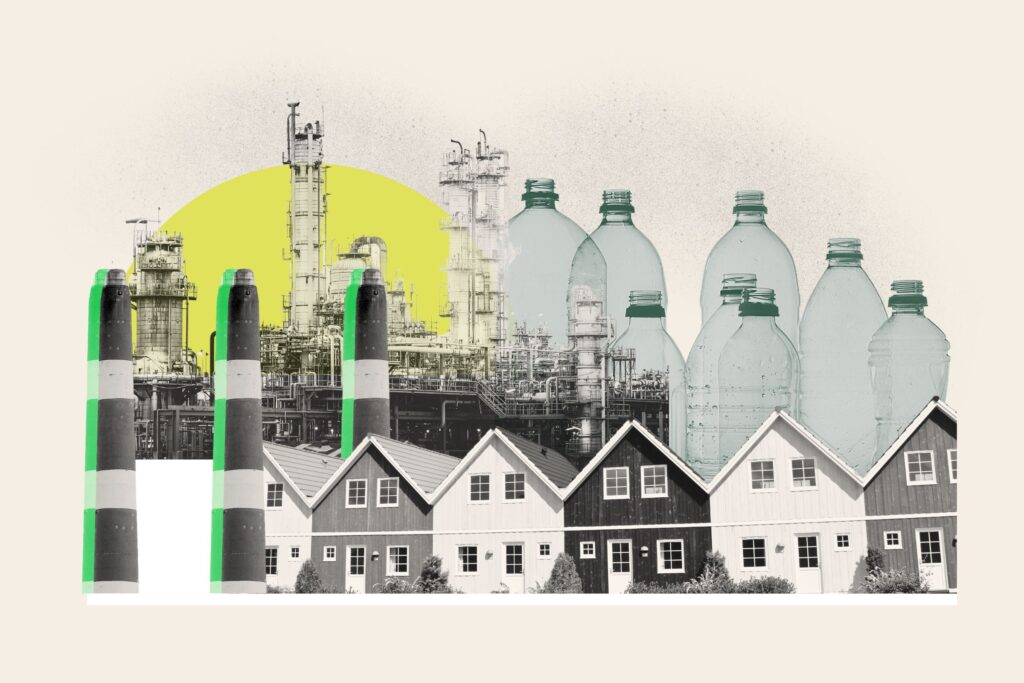Organizers in communities near the petrochemical plants that produce plastics hope that a global treaty to limit plastic waste can reduce the toxic emissions polluting their air and water.
Community and environmental groups have long argued that it is unfair that places such as the Houston shipping channel, the upper Ohio Valley and the parishes in southern Louisiana known as “Cancer Alley” have high concentrations of polluting petrochemical facilities in neighborhoods that are economically and politically marginalized.
“They are low-income, minority communities that oftentimes are sitting right in the same spot where we’ve seen historic discrimination by facilities for years on years,” Beyond Petrochemicals Campaign Executive Director Heather McTeer Toney told Newsweek.
The campaign launched by former New York Mayor Mike Bloomberg’s philanthropy in 2022 aims to stop the expansion of more than 100 petrochemical facilities in the U.S.
Toney said her environmental activism started when she dealt with water contamination as mayor of Greenville, Mississippi, a majority Black city in the Mississippi Delta.
“When you see industry continually identifying your community as a sacrifice so that the rest of the world can have their plastic fork with their takeout, it begs the question, are we really focusing on the health and well-being of all of our citizens?” Toney asked.
She joined leaders from fence-line communities in a delegation to the latest United Nations negotiations on a global plastics treaty in Busan, South Korea, late last month. Those talks ended December 1 without an agreement for a treaty, and the U.N. Environment Programme announced that it will schedule another round of talks in 2025.
The treaty negotiators are considering a range of policy actions to limit the environmental and human health damage from plastic waste, including improvements to waste collection, the elimination of the most harmful plastics and ways to boost the woefully low rates of plastic recycling.
But for the people living near petrochemical plants, one policy approach is far more important, Toney said: a limit on the total amount of new, or “virgin,” plastic production.
“We have to get to a place where we’re turning off the tap or at least turning down the production to deal with the plastic waste we have and stop creating as much,” she said. “Honestly, this is not a situation we can recycle our way out of.”
A proposed cap on plastic production proved to be the most difficult sticking point in the negotiations, as the petrochemical industry and petroleum-producing nations such as Saudi Arabia objected to limits on growth. But Toney and her colleagues from fence-line communities said the talks left them hopeful that a strong treaty might help ease the pollution burden they bear from plastics.
The View From ‘Cancer Alley’
In the roughly 85 miles between Baton Rouge and New Orleans, the concentrated pollution from approximately 200 petrochemical plants and refineries has earned this stretch of the lower Mississippi River the moniker Cancer Alley.
Robert Taylor and his daughter Tish Taylor live in the town of Reserve in St. John the Baptist Parish where they formed the group Concerned Citizens of St. John in 2016 after learning from the U.S. Environmental Protection Agency how polluted their community had become.
“People were suffering from all these illnesses,” Robert Taylor told Newsweek, listing the family, friends and neighbors who had fallen sick. “We didn’t know what it was about, why it was happening. But we have found out now.”
EPA Administrator Michael Regan visited in 2021 and spoke with residents about the extraordinarily high risks of asthma, cancer and other diseases related to air pollution from industry in the area.
The agency launched a cumulative impact assessment to better understand the combined health effects of various pollution sources and took enforcement action against some polluters. A settlement agreement reached last year with chemical company Evonik will cut toxic emissions from its facility in the parish, the EPA said.
Another enforcement action against Denka Performance Elastomer is still pending. Japan-based Denka took over the facility in St. John Parish from DuPont and makes the synthetic rubber neoprene.
The EPA determined in 2023 that the facility’s emissions of the likely carcinogen chloroprene were so high that it was an “imminent and substantial endangerment” to the community, and the agency sought a court injunction to order immediate pollution controls. The EPA also set stricter limits on chloroprene emissions.
Denka has challenged the EPA’s measurements of chloroprene and won a delay in enforcement orders from state environmental regulators while the company installed new pollution controls. In September, the EPA asked a federal judge to restart its stalled lawsuit against the company. Denka did not respond to an emailed request for comment for this story.
The Taylors said they were especially alarmed by the EPA’s findings about how pollution from the Denka facility affected nearby schools.
“We got back the first readings that indicated, man, that Fifth Ward Elementary School was being bombarded with such a high level of those chemicals,” Robert Taylor said.
The EPA said children are “particularly vulnerable to mutagenic carcinogens like chloroprene” and that more than 300 students attended school within 450 feet of Denka’s facility.
Robert Taylor said the school dates to the late 1940s, and when it served as a high school, it’s where he got his education.
“It’s a longtime partner in the fabric of our community here,” he said.
The Concerned Citizens group pressed local officials to take action to protect the children. But to the Taylors’ dismay, the school board voted this fall to close the school.
“That’s not our plan, we’re not against the school,” Taylor said. “We’re against the poisoning of the school and of the children.”
Tish Taylor described how the pervasive pollution in her town took a toll on all aspects of people’s lives, from their health to education and their ability to realize the value of home ownership—the traditional means for working people to build wealth.
“That’s the big deal to build your family up, you get your little house with your picket fence,” she said. “When in essence you bought into a toxic wasteland, and you and your children are destined to be sick.”
Plastics Growth Projected
In addition to airborne threats, communities neighboring plastics and petrochemical facilities are also subject to a disproportionate amount of water pollution, according to a recent report from a nonprofit environmental watchdog group.
The Environmental Integrity Project examined permits from 70 plastics and related chemical facilities and found the industry “dumps almost a half billion gallons of wastewater per day” into U.S. waterways, according to the report released last month.
Further, due to what the group called a “failure of EPA oversight,” many of those facilities face no limits on some pollutants they release, including dioxin, a carcinogen.
As demand for plastics grows, hydraulic fracturing, or fracking, has produced an abundant supply of natural gas, an important feedstock for making plastics. The report found 10 new plastics plants that are proposed around the country, along with 24 proposed expansions.
One of those new facilities is planned in St. James Parish, just upriver from where the Taylors live. FG, part of Taiwanese chemicals giant Formosa Plastics Group, plans to build what it calls the Sunshine Project, a $9.4 billion industrial complex to make ethylene and propylene, the chemical building blocks for many plastic products.
The Taylors and other public health advocates in the area are concerned about the additional pollution from that facility.
“If they’re allowed to do what they’re proposing to do, it’s going to be devastating on this area and everything downriver,” Robert Taylor said.
In an email to Newsweek, FG Director of Community and Government Relations Janile Parks said the project will meet state and federal standards.
“Throughout the development of the Sunshine Project, FG has listened to and invested in the community,” Parks said. “FG will uphold its commitment to operate safely, listen to community concerns, uphold rigorous environmental requirements, keep the community informed, support real needs in the parish and continue to be a responsible corporate citizen.”
The Taylors said their experience has taught them not to depend on such promises alone. Robert Taylor said he is also skeptical that any international agreement, such as one potentially coming from the U.N. treaty talks, could be enforced.
But Tish Taylor said she supports a strong treaty outcome that will limit the total production of plastics.
“It’s got to be something drastic to stop it,” she said. “We’re going to push for the most drastic thing we can.”
Common Cause in Health Concerns
The U.N. treaty talks in Busan were initially intended to be the culmination of two years of diplomatic work. But expert panelists at a Newsweek Horizons event earlier this month said that while it was disappointing to leave South Korea without a final treaty, they did not view the talks as a failure.
“I’m glad the treaty process is stalled because we are going to have a better treaty if we work out our issues,” Dr. Leo Trasande said during the panel discussion on December 4. Trasande, who directs the NYU Center for the Investigation of Environmental Hazards at the Grossman School of Medicine, has done groundbreaking research on the health threats from toxic components of some plastics. “Ultimately, we need independent science to carry the day,” he said.
Other panelists representing industry and environmental groups working to reduce plastic waste concurred that they saw progress toward a stronger treaty as preferable to agreement on a weak one.
Heather McTeer Toney of Beyond Petrochemicals agreed. She said she was heartened to see that more than 100 countries aligned on the goal of an ambitious treaty that includes a limit on plastic production.
Toney said the emerging science and growing public concern about the health effects of microplastics in our bodies also serve to connect people all around the world with those who are living next to plastic facilities.
“We’re never separated, really, from the people who are experiencing it, because while they’re right underneath that cloud of pollution, it’s the plastics themselves that are ending up in the placenta and breast milk of people all over the world,” she said. “I just have to believe that we are smarter than this.”
Read the full article here

















